
Choose Your Path: Venturing into RB Price Deflation
Running backs are rising from the dead (zone) in 2024.
A Trip Down Memory Lane
In 2022, 12 running backs went off the board before the end of the second round.
Javonte Williams, then the RB12, went at pick 19. For comparison, Tee Higgins (WR12) and Mike Williams (WR13) went off the board at picks 29 and 31, respectively.
Eventually, the RB fever cooled off. By the start of the fourth round, a flurry of wide receivers entered the picture. The WR15 (DJ Moore, 33rd overall) would go ahead of the RB15 (James Conner, 35th overall).
Later in the draft, the WR39 (DeAndre Hopkins, 78th overall) would be drafted rounds ahead of the RB39 (Melvin Gordon, 115th overall).
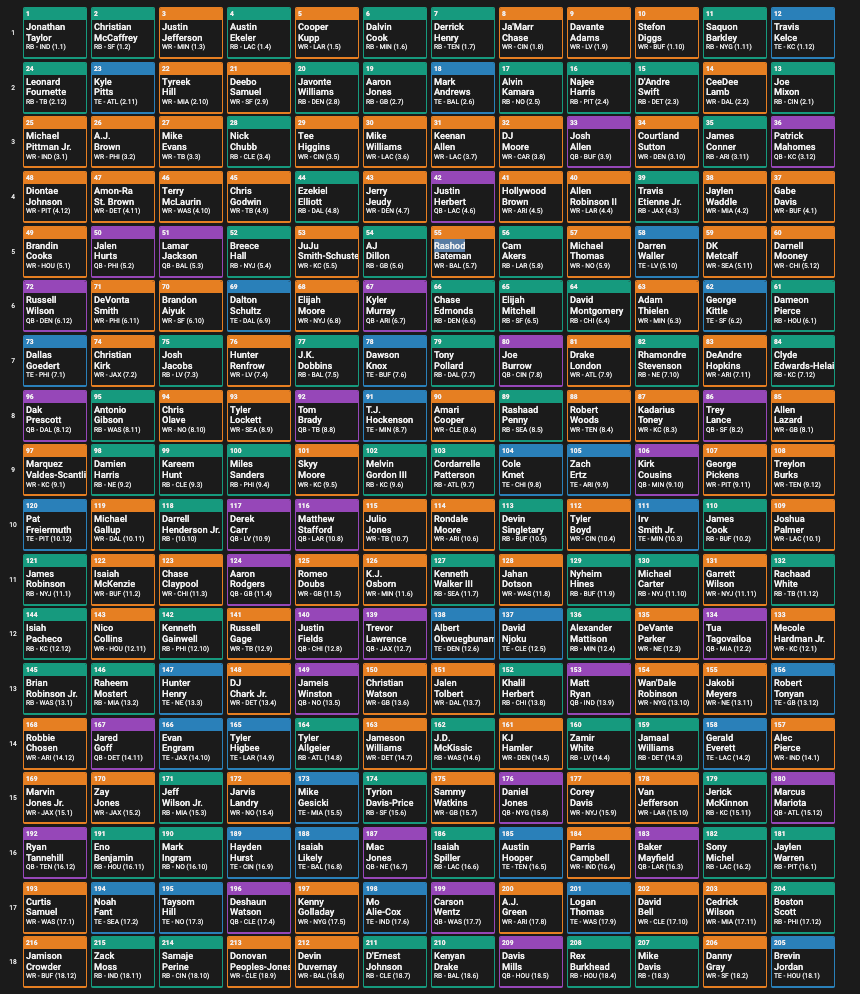
In 2023, the first wave of WR hysteria took the drafting community by storm. Gone were the days of early round running backs. Whereas the RB12 previously went at pick 19, now that player (Joe Mixon) would go at pick 38.
Partially fueled by a newly-minted BBMIII champion coining the phrase Legendary Upside, best ball rooms scrutinized early-round running backs more-so than ever before. Yet, Big Wide Receiver's propaganda campaign must have been lost in translation.
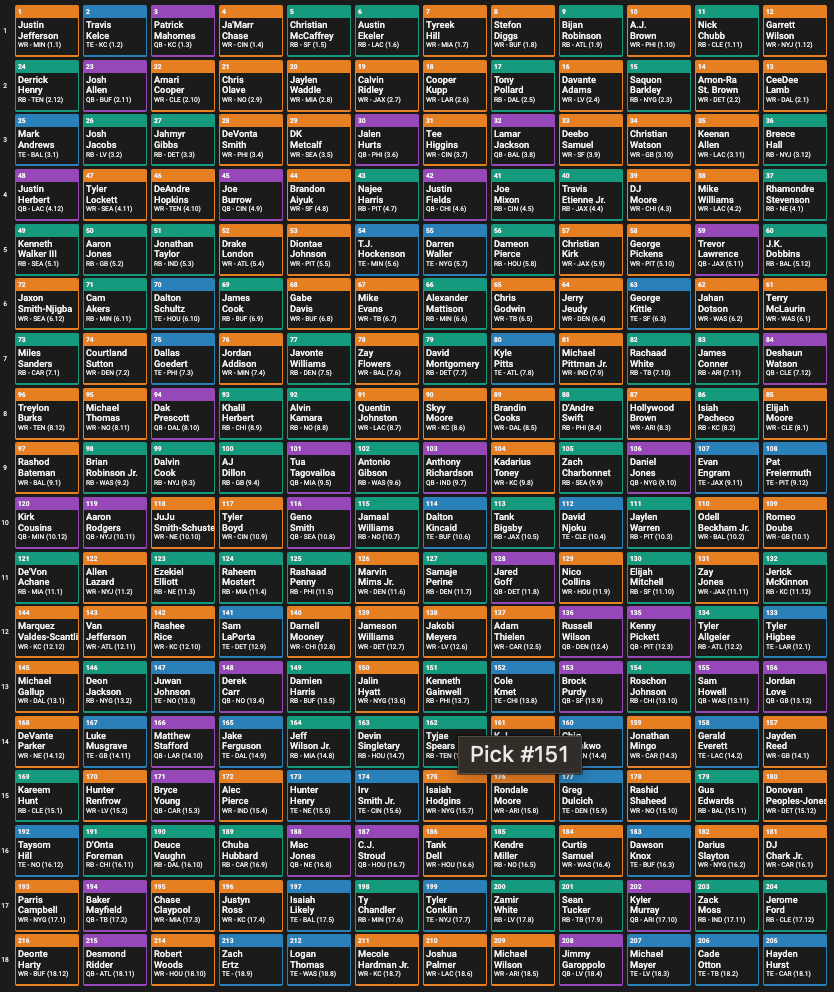
Drafters still eagerly selected dead zone profile backs in Round 4-7. While young and athletic or touchdown-fueled hits like Breece Hall, James Cook and David Montgomery (I would like to add J.K. Dobbins into the former bucket, too) exited out of the oft-rotten forest, most of its trees did not fare so well.
Alexander Mattison, Dameon Pierce and Miles Sanders all carried significant risk in the late fifth to sixth round, yet the projectable touches won out and anchored their ADPs before seasons that can only be described as catastrophic busts.
As we travel to the present, a drastically different drafting environment greets us in best ball lobbies. The early round running backs continue to experience price deflation, but the noteworthy changes start later down the board. Anywhere from the RB10 (ADP 38) to RB14 (ADP 63), deflation precipitously sets in. Through the middle single-digit rounds, once-pricey rushers are now relatively inexpensive.
But, as a caveat, this relative discount does not necessarily imply significant value. It only describes the statement, "Selecting a running back in the middle single-digit rounds in 2024 is far less punitive than doing so in 2023 or 2022."
Additionally, much of my comments on the 2022 and 2023 seasons assume that the running back pricing in those years was not efficient due to inflated pricing of volume-based bets. The results of those seasons alone should not vindicate the process of the thesis, and if anyone would like further reading on the traits to seek out, many of the LegUp core ideas about how to handle the running back position can be referenced above.
Shifting Prices
So far this off-season, the prices on 'dead-zone backs' have felt shockingly palatable. Third-round backs of 2022 now go as late as the sixth round in 2024, far outweighing the value gain of a fringe first-round back in 2022 that is now available in the late second round. Because later options have received such drastic price reductions, it makes early-round bets comparatively more expensive, even if they go later in drafts than they would have in 2022 or 2023.
Often, August sees the rise of 'projectable-touches' based bets as more casual drafters, fresh off a summer of touching grass, socializing, and not spending hours debating the Indianapolis Colts' TE room, enter draft rooms.
Intuitively, it makes sense that some percentage of the ADP value present in some of the price-deflated running backs would evaporate as we near kickoff. So, here are my semi-educated guesses at how the ADPs from the Isiah Pacheco through Javonte Williams range will shake out (Not financial advice).
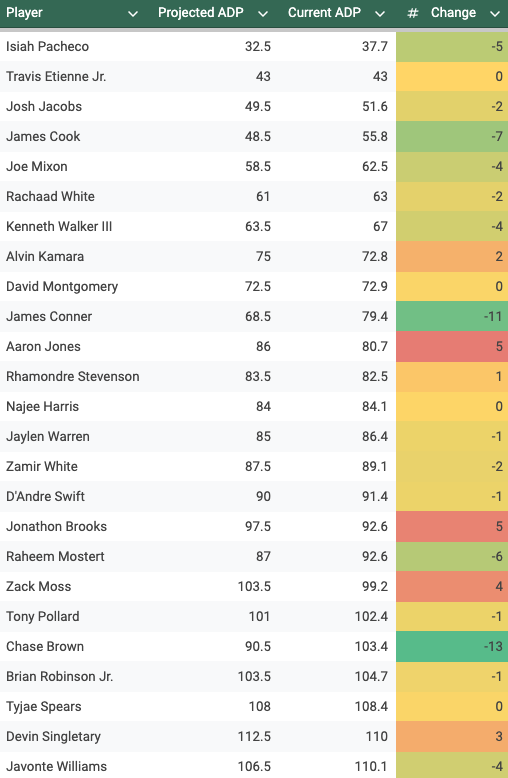
I do not think building a portfolio based on one's expectation of future market activity to be a significant value add (especially with one month before the season). But there are sometimes clear opportunities where forecasting market activity comes in handy.
Here were my thoughts on Pacheco early this summer in rankings discussions:
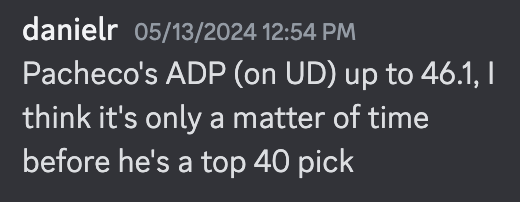
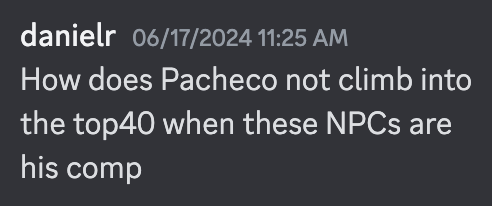
We've seen Pacheco rise over half a round...and I don't think we're done. The hype out of Chiefs camp has been notable, even exceeding my bullish expectations. I'm not sure I would draft him at ADP ~32.5, but I'd like to feel comfortable with my exposure prior to having to make that call.
On the Arizona Cardinals' backfield, the negative buzz on Trey Benson has oddly failed to lower his ADP into an appropriate range, just as James Conner's rise has not moved as quickly as I expected. James Conner at the 8-9 turn was a phenomenal pick. James Conner at the 7-8 turn still has me quite interested (he has started to rise far past this as I've churned out this article). Even in the mid 7th, with limited WR bets available, I would understand an overweight position on Conner. Once we get into the top 72 picks, I would hesitate (though, I think the market moves in this direction).
Buzz out of Minnesota Vikings' camp suggests more of a split between Ty Chandler (a phenomenal pick at the 12-13 turn, for as long as he stays there) and Aaron Jones than their early-August ADPs suggest.
In an environment with affordable projectable volume bets, taking a stab at a player that is disproportionately likely to see a significant uptick in volume during the fantasy playoff entices me. Recent comments from Dave Canales about Jonathon Brooks' likely return range starting at Week 3 or 4 do not fundamentally change the bet. Pairing Brooks with players that can offset his early missed games is a tremendous way for teams with Brooks to tread water until his return. If the Panthers' rookie falls into the 9th round without information suggested a setback in his recovery, he will likely displace Jaylen Warren as my most drafted running back.
A Picture Is Worth 1,000 Words
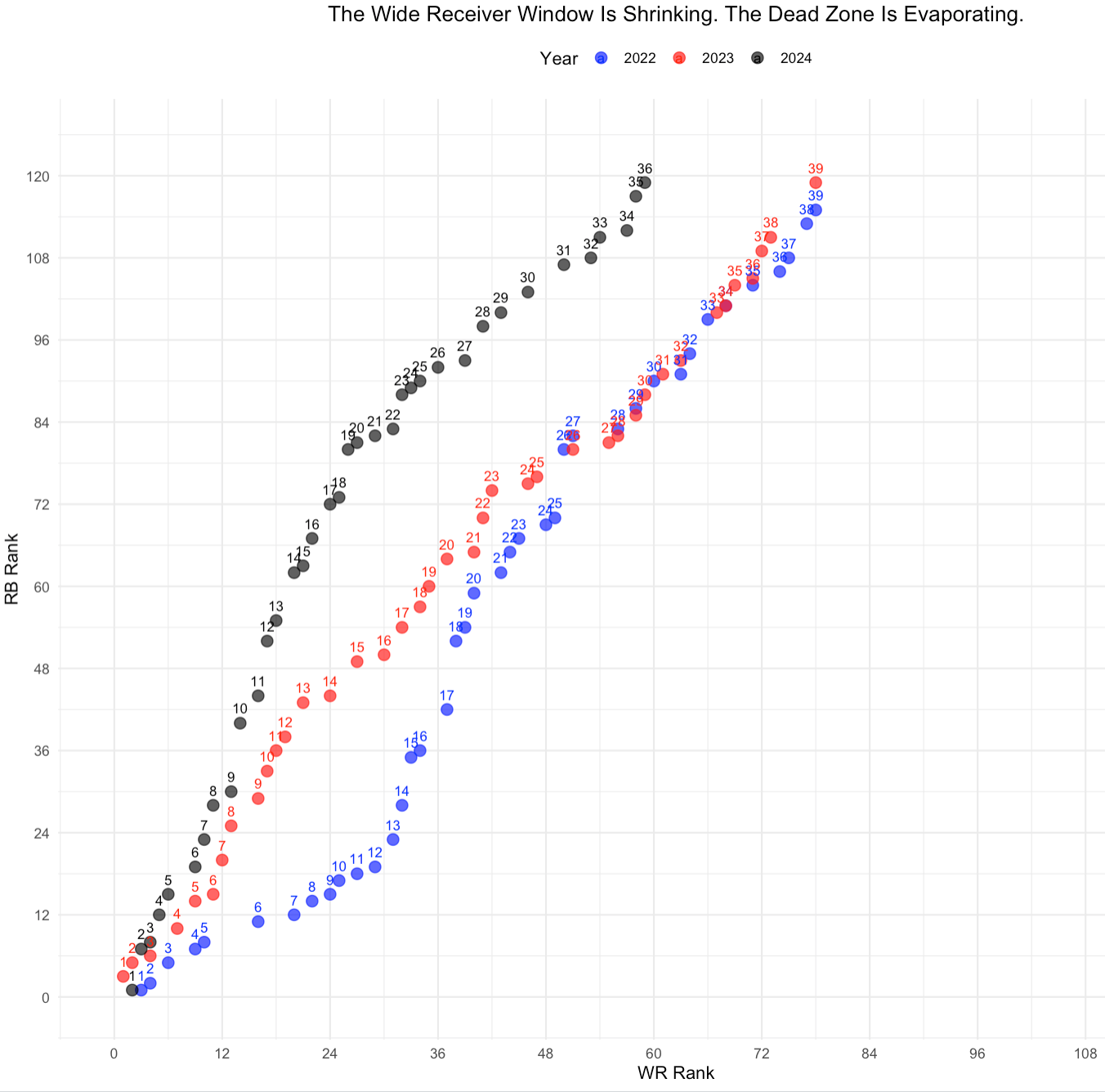
For interpretation purposes: The graph above compares the running backs ranked in the first ten rounds (top 120 picks) of Underdog Best Ball ADP in 2022, 2023 and 2024 to the wide receivers available at the same positional rank.
In 2022 and 2023, 39 running backs went in rounds 1-10. The chart then shows how early the first 39 wide receivers go, with the RB ADP shown on the Y axis and the WR ADP on the X axis.
For example, the blue 12 shows that the RB12 went roughly at pick 20 in 2022 and the WR12 went shortly before pick 30.
Large horizontal areas with no dots represent areas of the draft where no wide receivers were drafted in a given year.
Whereas large vertical jumps between dots denote massive ADP gaps between subsequent running back ADPs.
Essentially, the chart shows the opportunity costs of RBs and WRs the past three seasons.


